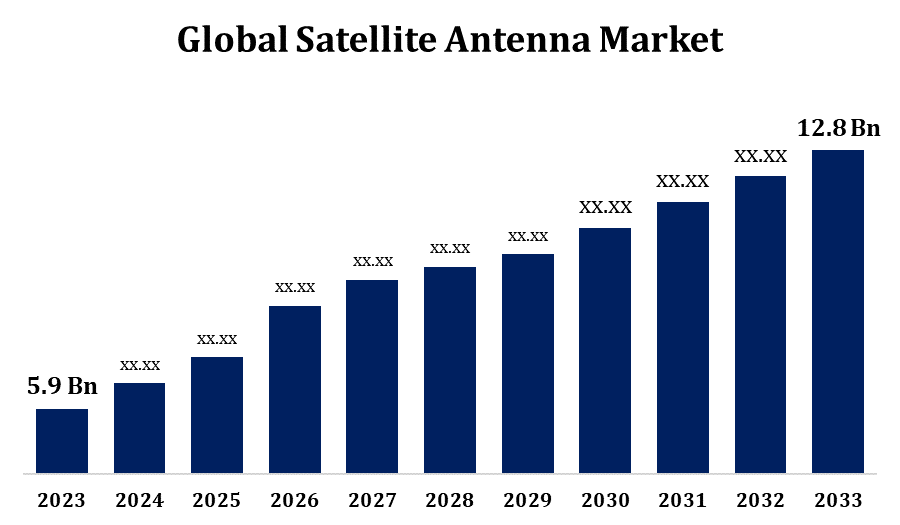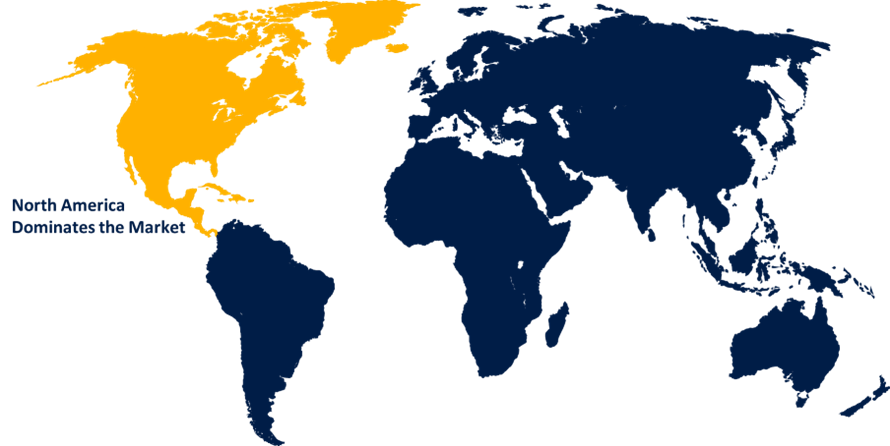Global Satellite Antenna Market Size To Worth USD 12.8 Billion By 2033 | CAGR of 8.05%
Category: Aerospace & DefenseGlobal Satellite Antenna Market Size To Worth USD 12.8 Billion By 2033
According to a research report published by Spherical Insights & Consulting, the Global Satellite Antenna Market Size to Grow from USD 5.9 Billion in 2023 to USD 12.8 Billion by 2033, at a Compound Annual Growth Rate (CAGR) of 8.05% during the forecast period.

Get more details on this report -
Browse key industry insights spread across 220 pages with 110 Market data tables and figures & charts from the report on the "Global Satellite Antenna Market Size, Share, and COVID-19 Impact Analysis, By Antenna Type (Parabolic Reflector, Flat Panel, Horn, Fiberglass Reinforced Plastic, and Others), By Application (Space, Land, Maritime, and Airborne), By Frequency Band (C Band, Ku/Ka Band, X Band, S and L Band, and Others), and By Region (North America, Europe, Asia-Pacific, Latin America, Middle East, and Africa), Analysis and Forecast 2023 - 2033." Get Detailed Report Description Here:https://www.sphericalinsights.com/reports/satellite-antenna-market
The satellite antenna market is steadily growing, driven by the increasing demand for high-speed connectivity, advancements in satellite technology, and expanding applications in defense, telecommunications, and space exploration. The rise of 5G networks and IoT applications is amplifying the need for reliable satellite communication, boosting demand for antennas with enhanced efficiency and bandwidth. Market expansion is fueled by geostationary, low Earth orbit (LEO), and medium Earth orbit (MEO) satellites, particularly for broadband services and remote sensing. Leading companies are focusing on lightweight, compact, and electronically steered antennas to enhance performance. Additionally, government and military investments in secure communication networks are accelerating growth. While North America leads the market, Asia-Pacific presents strong potential due to increasing space initiatives and growing demand for satellite-based internet services.
Satellite Antenna Market Value Chain Analysis
The satellite antenna market value chain consists of multiple stages, from raw material suppliers to end-users. It begins with suppliers providing essential materials such as metals, composites, semiconductors, and electronic components. Manufacturers then design and assemble satellite antennas, integrating advanced technologies like phased-array and parabolic reflectors. System integrators ensure seamless compatibility with satellites and ground stations, optimizing performance for communication, navigation, and remote sensing applications. Service providers deploy these antennas across industries, including telecommunications, defense, broadcasting, and scientific research. Finally, end-users—ranging from governments and enterprises to individual consumers—utilize satellite antennas for connectivity and data transmission. Continuous technological advancements, regulatory compliance, and strategic collaborations among industry stakeholders drive efficiency and innovation, shaping the evolution of the satellite antenna market.
Satellite Antenna Market Opportunity Analysis
The satellite antenna market offers substantial growth opportunities, driven by the increasing need for high-speed connectivity, expanding satellite deployments, and advancements in communication technologies. The rise of low Earth orbit (LEO) satellite constellations, such as Starlink and OneWeb, is fueling demand for advanced, lightweight, and electronically steered antennas. The defense and aerospace sectors are also boosting market potential through investments in secure military communications and surveillance systems. Emerging markets in Asia-Pacific and Africa present further opportunities, supported by growing internet penetration and government-led space initiatives. Additionally, the integration of satellite antennas with 5G networks, IoT applications, and autonomous vehicles is opening new business avenues. Companies focusing on cost-effective, high-performance antenna solutions and strategic partnerships are poised to gain a competitive advantage in this evolving landscape.
The satellite antenna market is experiencing notable growth, driven by a shift toward smaller and more compact antennas. Technological advancements have led to the development of lightweight, high-performance antennas that improve mobility and efficiency. These compact antennas are particularly valuable in aerospace, defense, maritime, and commercial applications, where size and weight constraints are crucial. The increasing deployment of low Earth orbit (LEO) satellite constellations for broadband communication is further accelerating this trend, creating demand for adaptable and cost-effective antennas. Additionally, the integration of satellite antennas with 5G networks, IoT devices, and autonomous systems is fostering innovation in miniaturized designs. Companies investing in compact, electronically steered antennas with enhanced bandwidth and signal strength are well-positioned to gain a competitive advantage in this rapidly evolving market.
High manufacturing and deployment costs remain a significant obstacle, especially for advanced antennas with electronically steered arrays. The complexity of integrating satellite antennas with evolving communication networks, such as 5G and IoT, adds to technical difficulties. Additionally, interference issues, signal degradation, and regulatory restrictions affect antenna performance and market growth. The increasing number of low Earth orbit (LEO) satellites is creating congestion, leading to spectrum management challenges. Harsh environmental conditions, including extreme temperatures and space radiation, further impact antenna durability and reliability. Furthermore, competition from alternative communication technologies like fiber optics and terrestrial networks threatens market expansion. Overcoming these challenges requires continuous innovation, cost reduction strategies, and strong industry collaborations to enhance efficiency and competitiveness in the satellite antenna market.
Insights by Antenna Type
The parabolic reflector segment accounted for the largest market share over the forecast period 2023 to 2033. The growth of this segment is driven by its high efficiency, excellent signal reception, and diverse applications in telecommunications, broadcasting, defense, and space exploration. These antennas offer strong gain and directional capabilities, making them ideal for deep-space communication, weather monitoring, and satellite television. The increasing demand for high-speed internet and the expanding deployment of low Earth orbit (LEO) satellites are further accelerating adoption. Additionally, advancements in materials and design have led to the development of lightweight and compact parabolic antennas, enhancing performance and cost-effectiveness. Investments from governments and private enterprises in satellite communication infrastructure are fueling market expansion. With ongoing innovation and integration into emerging technologies like 5G and IoT, the parabolic reflector segment is set for sustained growth.
Insights by Application
The space segment accounted for the largest market share over the forecast period 2023 to 2033. The growing deployment of low Earth orbit (LEO) satellite constellations, such as Starlink and OneWeb, is fueling demand for advanced satellite antennas with improved efficiency and signal strength. Both governments and private enterprises are making substantial investments in satellite-based broadband, remote sensing, and deep-space missions, further accelerating market expansion. Technological advancements in phased-array antennas and miniaturized designs are enhancing performance while reducing weight and costs. Additionally, the integration of artificial intelligence (AI) and software-defined technologies is advancing antenna capabilities. As space exploration initiatives and global connectivity projects continue to rise, the space segment is poised to be a major driver of growth in the satellite antenna market.
Insights by Frequency Band
The Ku/Ka band segment accounted for the largest market share over the forecast period 2023 to 2033. The growth of this segment is driven by the rising demand for high-speed data transmission, broadband connectivity, and advanced communication networks. The Ka-band, with its higher frequencies and greater bandwidth compared to the Ku-band, is gaining popularity in aviation, maritime, defense, and enterprise networks. The increasing deployment of low Earth orbit (LEO) and medium Earth orbit (MEO) satellite constellations, such as Starlink, OneWeb, and SES, is further boosting demand for Ku/Ka band antennas. These frequency bands support faster internet speeds and more reliable communication, making them crucial for 5G backhaul, inflight connectivity, and broadband access in remote areas.
Insights by Region

Get more details on this report -
North America is anticipated to dominate the Satellite Antenna Market from 2023 to 2033. The market growth is driven by the presence of major players like SpaceX, Lockheed Martin, and Northrop Grumman, coupled with substantial government investments in satellite communication. The growing deployment of low Earth orbit (LEO) satellites for broadband services, such as SpaceX’s Starlink, has significantly increased demand for advanced satellite antennas. Additionally, North America is leading the integration of satellite technology with 5G networks, IoT, and autonomous systems, opening new opportunities for antenna manufacturers. The rising demand for military and defense applications, including secure communications and surveillance, also supports market growth. With ongoing technological advancements and robust infrastructure, North America maintains its dominant position in the global satellite antenna market.
Asia Pacific is witnessing the fastest market growth between 2023 to 2033. The increasing demand for satellite-based broadband in remote regions, along with the expansion of 5G and IoT applications, is driving market growth. Furthermore, the defense and military sectors are investing in advanced satellite communication technologies for surveillance and secure communications. The rise of commercial space companies and affordable satellite solutions is also boosting growth prospects. As infrastructure development continues and technological advancements progress, the Asia-Pacific region is emerging as a major player in the global satellite antenna market.
Recent Market Developments
- In May 2024, Pasternack has launched a new line of millimeter-wave horn antennas specifically designed for test and measurement applications. This series features dual-polarized horn antennas and waveguide probes, providing improved flexibility and performance across a frequency range of 22 to 170 GHz.
Major players in the market
- SES
- EchoStar
- Hispasat
- Inmarsat
- Eutelsat
- L3Harris Technologies
- Thaicom
- Telesat
- Arabsat
- Viasat
- Globalstar
- Iridium
- Intelsat
- TurkSat
- Apstar
- Others
Market Segmentation
This study forecasts revenue at global, regional, and country levels from 2023 to 2033.
Satellite Antenna Market, Antenna Type Analysis
- Parabolic Reflector
- Flat Panel
- Horn
- Fiberglass Reinforced Plastic
- Others
Satellite Antenna Market, Application Analysis
- Space
- Land
- Maritime
- Airborne
Satellite Antenna Market, Frequency Band Analysis
- C Band
- Ku/Ka Band
- X Band
- S and L Band
- Others
Satellite Antenna Market, Regional Analysis
- North America
- US
- Canada
- Mexico
- Europe
- Germany
- Uk
- France
- Italy
- Spain
- Russia
- Rest of Europe
- Asia Pacific
- China
- Japan
- India
- South Korea
- Australia
- Rest of Asia Pacific
- South America
- Brazil
- Argentina
- Rest of South America
- Middle East & Africa
- UAE
- Saudi Arabia
- Qatar
- South Africa
- Rest of the Middle East & Africa
About the Spherical Insights & Consulting
Spherical Insights & Consulting is a market research and consulting firm which provides actionable market research study, quantitative forecasting and trends analysis provides forward-looking insight especially designed for decision makers and aids ROI.
Which is catering to different industry such as financial sectors, industrial sectors, government organizations, universities, non-profits and corporations. The company's mission is to work with businesses to achieve business objectives and maintain strategic improvements.
CONTACT US:
For More Information on Your Target Market, Please Contact Us Below:
Phone: +1 303 800 4326 (the U.S.)
Phone: +91 90289 24100 (APAC)
Email: inquiry@sphericalinsights.com, sales@sphericalinsights.com
Contact Us: https://www.sphericalinsights.com/contact-us
Need help to buy this report?